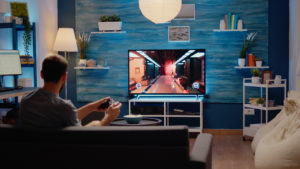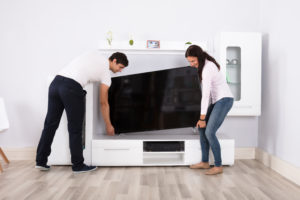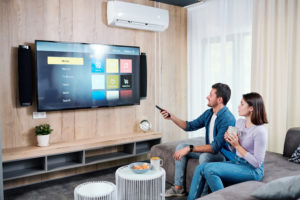
Know your LED: How to buy the right TV
Buying a TV used to be straightforward. You'd simply pick a model with the largest screen that you could afford, and you’d be home on the couch with the remote in no time.
Now, there's a whole new vocabulary with bewildering terms like 8K, HDR and Quantum Dots. What does any of it mean? And how do you determine whether that $3000 television really is worth more than the one half its price?
Firstly, let’s just take some out of the equation. Although you still see them around, LCD and plasma TVs are heading the way of video recorders, so we’ll focus on LEDs. Their superior energy efficiency has helped push them to the top of buyer wishlists, both from a cost-saving and environmental point of view.
Now, we’ll help you navigate the world of acronyms, brands and warranties to find a TV that works best for you.
OLED
The O in OLED stands for organic because its pixels - the tiny illuminations that form the images on your screen - contain organic matter. They’re not derived from plants, though. It’s just that, technically speaking, the materials used in it are organic. We won’t bore you with the details but it’s good to know so you don’t choose OLED for the wrong reasons.

OLED TVs emit their own light rather than relying on the backlight with the panel in front of it. The result is much better refresh rates (good for gaming), amazing contrasts and best-in-class image quality. This makes OLED TVs perfect for darkened home theatre rooms.
The downside of OLED TVs is they don’t perform as well in bright environments. Plus, they are only available in large screen sizes, so if you want one you'll need a generous sized space so it won’t dwarf your room.
QLED
Samsung's QLED TVs use a backlight made from Quantum Dots instead of conventional LEDs. These nanoparticles make the pixels much less prone to oxidation, allowing them to be placed in different positions within the TV. This means that the colours they produce are more accurate and contrasting.
The main difference between a QLED TV and an OLED panel is the brightness. OLED screens can't compete with QLED screens on a pure brightness basis, but they can achieve the same contrast with less brightness. The difference is more pronounced in well-lit environments or when watching HDR content. As a result, a QLED TV will be easier on the eyes if your entertainment area gets a lot of sunlight.
mini-LED
Some call this the “pinnacle of LED television technology” thanks to the combination of mini LED panels and Quantum Dot NanoCell colour technology. As the name implies, mini-LED TVs use smaller diodes – the semiconductor devices that emit light when electricity passes through them – so one TV set can pack thousands more than OLED and QLED.
The result? The image quality is impressive. The smaller-sized LEDs make the display more vivid and realistic, which means the black levels will be darker, helping to adjust the contrast levels. So whether you want it for a darkened theatre room or sunlight-rich living room, a mini-LED TV will do justice to your favourite movie.
The only drawback is it’s an emerging technology, so you have to fork out more cash to get one.
Should I know my micro-LED from my ULED?
You might hear about other types of LED TVs, such as micro-LED, ULED and XLED. Don’t worry about any of them. Micro-LEDs are relatively new and are super pricey at the time of writing. Also, there’s not many of them available on the market. And ULED and XLED are just names the marketing people at Hisense and Vizio, respectively, used to set themselves apart from the competition.
Screen size
Screen size is one of the most important specifications - don’t take it for granted. Choose a size that is optimal for your entertainment area, presuming budget permits.

Besides being more immersive, bigger TVs show more details than smaller ones. And have you ever heard anyone complain about their TV being too big? Just ensure it will fit in your current living space without overpowering it. And if you’re going to mount it on the wall, ensure you have it installed properly so that your expensive new toy doesn’t come crashing down because the brackets - or the wall - can’t support the weight.
Resolution
Before divulging the most common mistake you can make when choosing a TV resolution, let’s first answer the question, what is TV resolution? Simply put, it’s the number of horizontal and vertical lines that make up the image on your screen. The higher the resolution – that is, the more horizontal and vertical lines your TV has – the sharper the picture.
There are numerous resolutions available but for simplicity’s sake, let's focus on 1080p, 4K and 8k because these are common in more recent TV models, especially the bigger ones.
1080p means that there are 1920 horizontal lines and 1080 vertical lines on the screen. It’s also called a full high-definition display or full HD display.
A 4K display has a resolution of 3840 pixels horizontally and 2160 pixels vertically. Its resolution is four times higher than a 1080p display and therefore provides sharper images and more details. Another term for 4K is UHD or ultra HD.
An 8k display means that the TV has 4320 horizontal lines and 2880 vertical lines, resulting in an incredibly sharp image. But here’s the kicker: at this time there is very little content that can take advantage of an 8K resolution.
Go to YouTube and the highest video quality you can find is 4K. Go to Google and search for 8k movies and you’ll get “8K movies are yet to come” in response. 4K is not widespread yet, either, and a lot of consumers are very happy with their 1080p, so don’t fall for the hard sell yet.
HDMI port
A HDMI port is an input/output port on electronic devices that allows for the transmission of digital audio and video signals. HDMI ports are most commonly used to connect TVs to video source devices such as Blu-ray players and video game consoles. This is done by connecting a HDMI port on the TV with a special cable with a HDMI connector on one end and another component with jacks for audio output, video input, and USB power.
The latest HDMI port is HDMI 2.1. Whilst it’s a big leap from the 2.0, you don’t need it unless you’re a gamer. Even then, you won’t find much use for it unless you’re a high-end PC gamer, using the highest graphic cards. Most, if not all games and gaming consoles, now run on 60 fps at 4k resolution, which can be supported by the existing HDMI 2.0 chipset. Yeah, salespeople may tell you 2.1 supports VRR or variable refresh rate and it’s good for this and that, but you really don’t need it.
Refresh rates
The refresh rate is also an important spec to look for when buying a TV. Refresh rate means the number of times in a second that the picture on your TV is refreshed. The more refreshes per second, the better it looks.
Most TVs these days have a refresh rate of 60Hz, which means that the TV is refreshing 60 times per second. But there are some that offer rates as high as 240Hz. If you plan on watching a lot of action-packed content, such as sports or video games, don’t forgo high refresh rates to save on your purchase. Buy a TV with the highest refresh rate you can afford.
Top tips for buying your TV
The best way to avoid wasting money and time is to shop for a TV in person. By all means, do some research online first so salespeople can’t overwhelm you with ‘TV speak’. But actually seeing, touching and interacting with TVs will help you make a better decision for your needs.

When you visit a retail store, ask the seller to turn off demo or shop mode. Most TVs feature carefully chosen videos, which are meant to impress you.
Choosing which to buy, of course, doesn’t stop at all the features and specs. We have to look beyond the numbers and consider the brand’s lifespan, reputation and warranty.
How long should a TV last?
According to a 2018 survey by Choice, the average life expectancy of TVs varies considerably:
-
- Budget/entry-level: 5 years
- Mid-range: 8 years
- High-end: 11 years
While the survey is done with LCD TVs, the same may apply to LED TVs with a bulb lifespan of 100,000 hours. That’s roughly 11.5 years. But note that the end of a lifespan does not mean that your TV will stop working it means after that specified period, it can only provide half the brightness of a brand new model.
Brands with the best reputation
With all the brands in the market, how do you know which ones to buy? We looked at what the experts recommend, in no particular order:
-
- Samsung. Most, if not all, TV reviewers rank Samsung as the best all-rounder, because it offers an innovative range, modern technology and exceptional picture and sound quality.
- LG. Experts believe Samsung’s closest competitor to be on par. Perhaps the only difference is the type of LED they use. Whereas Samsung focuses more on QLEDs, LG is a huge OLED proponent.
- Sony. Another reputable brand, thanks to the sound quality of its TVs. The image quality is strong, too, especially the higher-end models, but its audio quality is truly something else.
- Hisense. If you’re a budget TV buyer, you can always rely on Hisense. It’s got amazing displays and decent audio quality, which is why it has carved out a name at the cheaper end of the market.
- TCL. Another budget brand, TCL is well-loved for its dedication to low-cost TV. If you're expecting its display and processing to take a hit, you’ll be pleasantly surprised. For what you get at the price point, there’s nothing much to complain about.
Finding a good warranty
The TV brands mentioned go over and beyond when it comes to TV features and specifications. Sadly, the same cannot be said about their warranties.
Only Hisense and TCL offer warranty periods of three years or 36 months (unless it’s been used for business or commercial purposes, in TCL’s case). The rest offer just one year’s warranty.
This shouldn’t put you off, however, because, under Australian Consumer Law (ACL), you have consumer guarantees as long as the item is bought from a merchant within the country.
“The consumer guarantees which apply regardless of any warranties suppliers sell or give to you, for a reasonable time depending on the nature of the goods or services. This means consumer guarantees may continue to apply after the time period for the warranty has expired.”
To know what’s covered by the consumer guarantees, have a look at this particular ACL webpage.
Should I buy an extended warranty?
The short answer is no. The long answer is no, it’s a waste of money.
“Many extended warranties largely replicate or underplay your existing rights under the Australian Consumer Law. They’re a sales trick to squeeze more money out of you that ignore your existing rights under the law,” says Julia Steward, consumer rights expert at Choice.
If the salesperson keeps pushing you to buy an extended warranty, ask them what it offers that’s not covered by the consumer guarantees provided by ACL.
Is the warranty affected if I buy the TV in instalments?
How you pay for an item should not affect its warranty. That is, you should get the same coverage whether you paid for a TV set in full or in instalments. For refunds, of course, you can only be refunded the amount you have paid so far.
But make sure you have proper proof of purchase. If you’ve lost the receipt (and we recommend both filing them somewhere you’ll remember and photographing and emailing them to yourself for safekeeping), you can show either of the following:
-
- A credit card statement that itemises the goods
- A confirmation or receipt number from a phone or internet transaction
- A warranty card showing the date, price and place of purchase
- The serial or production number if it's stored on the retailer's computer
What if I want to return the TV?
Two common reasons people return their purchase are because their item is faulty and because they do not feel the price/value fits what was advertised. In this case, the best thing you can do is to return the product to the store you bought it from. If that’s not possible, then contact the manufacturer or retailer.

If your TV’s on the blink and you can’t get it to the point of sale, it can be couriered. Depending on the size, you may have to cover the transportation costs initially, but you are entitled to a refund of a reasonable amount of these costs. So keep your receipt.
If your TV is too large to fit in your car, the supplier is responsible for the postage and the fees. But if the product is found not to have a fault, you may be required to reimburse the costs.
Alternatively, you can request an authorised repairer through the seller, where you purchased the TV, or the TV manufacturer’s customer service to attend your location.
If you don’t have a TV while the problem is being looked at, as long as the problem is not your fault (eg, you didn’t spill a cup of coffee over it), the supplier can repair or replace it or refund your payment covering the decline in the product’s value. The choice of remedy is your decision.
Determining which applies to your case depends on the fault – whether it’s minor or major – and how long it will take to repair or replace the item. You may opt to have your TV repaired somewhere else if the merchant doesn’t provide remedy within a reasonable time. The costs incurred should be shouldered by the supplier.
If the latter refuses to honour warranties and/or consumer guarantees, lodge your complaint with us.






